Topics
Category
Era
Red River Carts
Red River carts were used by the Métis for bison hunts and for trade between the heart of the Red River Colony (present-day Winnipeg) and St. Paul in the early 1800s. By the mid-1800s, nearly continuous use of the carts had worn trails into the prairie grasses. These trails connected the hunting-farming culture of the Métis on the Red River with the growing industrial culture of St. Paul on the Mississippi River.
Fur traders in the seventeenth and eighteenth centuries used waterways to travel to the upper Great Plains. As they built posts further inland and west, however, they wanted easier land transportation. In 1801, Alexander Henry (the Younger), a trader for the North West Company, set up a post near present-day Pembina, North Dakota, and fashioned the precursor to the Red River cart. Henry wrote that the cart, made in 1801, had solid wheels “sawed off from the ends of logs whose diameter was three feet.”
The design of Henry’s cart likely derived from the carts in French Canada, where many of the workers at Pembina were from. Henry would later write that each cart was worth four horses to them “as it would require five horses to carry as much on their backs as one will drag in each of these large carts.”
After French Canadians introduced the cart to the Red River area, local Métis people started building and using what came to be known as the Red River cart. The Métis, people of mixed European and American Indian heritage, used the carts for their well-known buffalo hunts. After the establishment of the Red River Colony in present-day Winnipeg in 1811, they also used them for trade.
The Red River cart was made entirely of wood. The only tools needed to build it were an ax and an auger. Rawhide, or wood found along the route, was used to mend breaks. The cart was suspended between two large wheels, each more than five feet in diameter. The wheels had spokes that angled outward from the hubs to the rim, which helped stabilize the cart.
When the wheels were taken off, they could be lashed together and, concave side up, used as a raft to cross water. When they were used on land, their squeal could be heard from miles away because they could not be greased; grease would mix with the trail dust and either stop the wheels from turning or wear down the axle. The axle supported the cart’s weight and, even with grease, wore out quickly. Travelers carried spare axle on their journeys; a typical trip from Winnipeg to St. Paul would require four or five.
Drivers used harnesses to hitch their carts to a horse or ox, whose head went through a collar. They attached the collar to the cart’s shaft with leather straps called tugs. Usually, the cart was pulled by one animal, but there are some records of carts being pulled by two. Horses were first used, but oxen, which could pull up to 1,000 pounds, also pulled carts after their introduction to North Dakota in 1821.
The Métis regularly traveled from the area of the Red River Colony to St. Paul, organizing caravans with as many as 200 carts. They carried bison hides, fur, meat, and pemmican to trade, and they returned home with manufactured goods, ammunition, food, tobacco, seed, and other imports. In addition to carrying goods, the carts provided protection. Drivers hung hides or canvas on them to shield themselves from weather and parked them in circle formations around camps to guard against attack.
There were no roads at first, so the Métis created their own trails with the carts. They created three main routes: the Woods Trail, the Plains Trail (on the east side of the Red River), and the Plains Trail (on the west side of the Red River). For a time, the trading routes were commercially and politically comparable to the Santa Fe Trail. Because expansion in the American north was not as successful as it was in the south, however, the significance of the Red River trails and the carts that made them is not as well recognized. In the 1850s and 1860s, steamboats and railways replaced the Red River carts as the region’s main modes of transportation.
Bibliography
Brehaut, Harry Baker. “The Red River Cart and Trails: The Fur Trade.” Transactions of the Manitoba Historical Society 3, no. 28 (1971–1972). http://www.mhs.mb.ca/docs/transactions/3/redrivercart.shtml
Gilman, Carolyn. “Perceptions of the Prairie: Cultural Contrasts on the Red River Trails.” Minnesota History 46, no. 3 (Fall 1978): 112–122. http://collections.mnhs.org/MNHistoryMagazine/articles/46/v46i03p112-122.pdf
Gilman, Rhoda, Carolyn Gilman, and Deborah M. Stultz. Red River Trails: Oxcart Routes Between St. Paul and the Selkirk Settlement, 1820–1870. St. Paul: Minnesota Historical Society Press, 1979.
History of the Red River Valley: Past and Present, Including an Account of the Counties, Cities, Towns, and Villages of the Valley from the Time of their First Settlement and Formation. Chicago: Cooper, 1909.
https://archive.org/details/historyofredrive01chicuoft
North Dakota State Government. The Métis and Red River Carts.
http://ndstudies.gov/gr4/frontier-era-north-dakota/part-2-fur-trade-red-river/section-4-métis-and-red-river-carts
Nute, Grace Lee. “The Red River Trails.” Minnesota History 6, no. 3 (Fall 1925): 278–282.
http://collections.mnhs.org/MNHistoryMagazine/articles/6/v06i03p278-282.pdf
Peihl, Mark. “Red River Carts Reviewed.” Clay County Archives, Historical and Cultural Society of Clay County, Moorhead.
Related Resources
Primary
Henry, Alexander. The Journal of Alexander Henry the Younger, 1799–1814: Red River and the Journey to the Missouri. North York: Champlain Society, 1988.
Nelson, George. My First Years in the Fur Trade: The Journals of 1802–1804. St. Paul: Minnesota Historical Society Press, 2002.
Secondary
Gilman, Rhoda. “The Last Days of the Upper Mississippi Fur Trade.” Minnesota History 42, no. 4 (Winter 1970): 122–140.
http://collections.mnhs.org/MNHistoryMagazine/articles/42/v42i04p122-140.pdf
Nute, Grace Lee. “New Light on Red River Valley History.” Minnesota History Bulletin 5, no. 8 (November 1924): 561–572.
Peterson, Jacqueline, and Jennifer S. H. Brown. The New Peoples: Being and Becoming Métis in North America. Winnipeg: University of Manitoba Press, 1985.
Web
Library and Archives Canada. Thomas Douglas, Earl of Selkirk (June 20, 1771–April 8, 1820).
http://www.bac-lac.gc.ca/eng/discover/politics-government/canadian-confederation/Pages/thomas-douglas.aspx?wbdisable=true
Related Audio
Red River cart squeal
The sound of a replica Red River cart in motion. Archivist Mark Peihl of the Historical and Cultural Society of Clay County explains, "We have in our collection a wonderful replica cart built by John Hall and Eddie Gudmundson. It’s a very typical looking cart. It weighs about 400 pounds and could carry 800 pounds. The heart of the cart is a pair of heavy, parallel, twelve-foot-long shafts. The single draft animal stood between the shafts to pull. The box rests on the shafts, mortised to keep it in place. The corner posts and side rails of the box are ingeniously located to allow side boards to be slipped in to keep objects from falling out of the cart. The all-wood carts were easy to repair with wood found along the route. The hubs were left ungreased––trail dust would mix with lubricants and work like sandpaper. So they squeaked. Of the dozens of cart trip descriptions I’ve read, every one mentions the annoying squeal of the carts." Used with the permission of the Historical and Cultural Society of Clay County.
More Information
Articles
Related Images
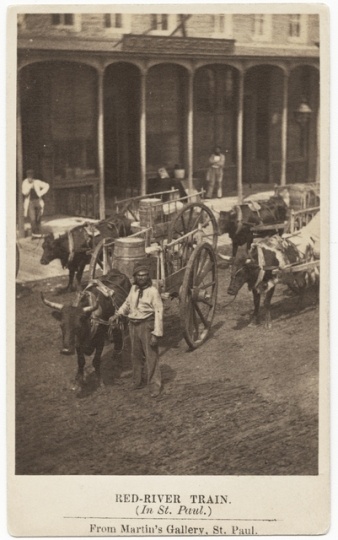
Red River train, St. Paul
A man and a Red River cart train, ca. 1859. Photograph by Martin’s Gallery.
Public domain
Holding Location
Articles
More Information
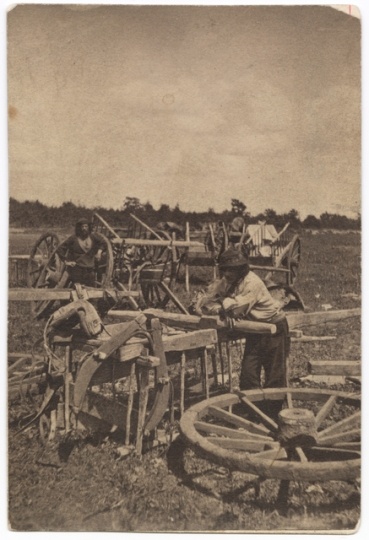
Preparing a Red River cart train at Pembina for a trip to St. Anthony Falls
Two men, probably Métis, preparing a Red River cart train at Pembina, 1856.
Public domain
Holding Location
Articles
More Information
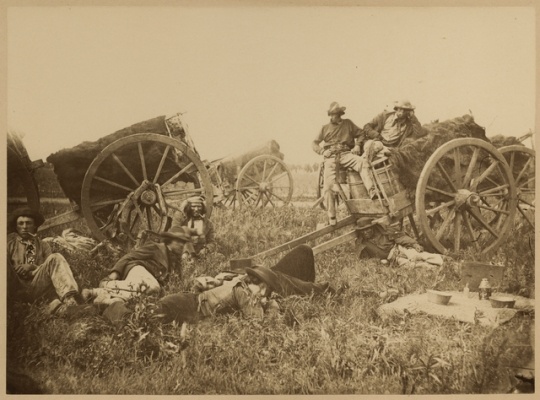
Red River carts from Pembina encamped on St. Anthony Hill
Red River Carts encamped, 1858.
Public domain
Holding Location
More Information
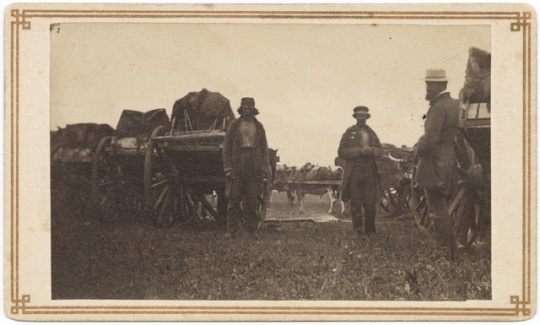
Red River carts in camp
A camp with Red River carts, ca. 1860.
Public domain
Holding Location
Articles
More Information
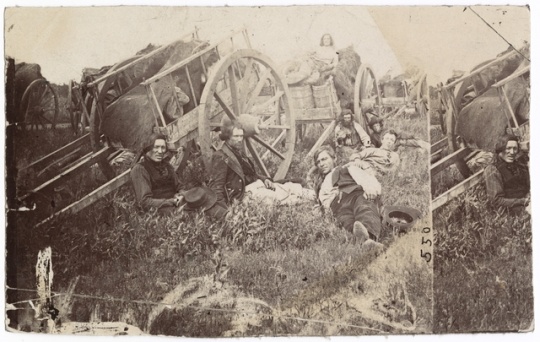
Métis drivers with Red River ox carts
Métis drivers with Red River ox carts, probably in Minnesota, 1860. Photograph by Benjamin Franklin Upton.
Public domain
Holding Location
More Information
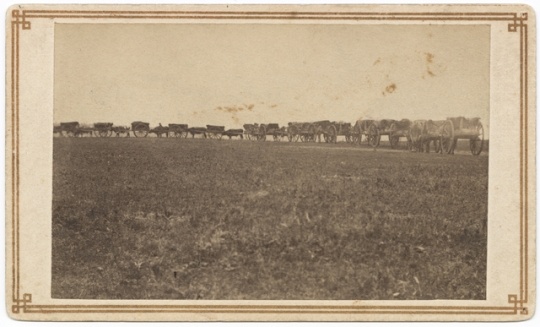
Ox-cart train on Red River Trails
An ox-cart train on a Red River trail, ca. 1860.
Public domain
Holding Location
Articles
More Information
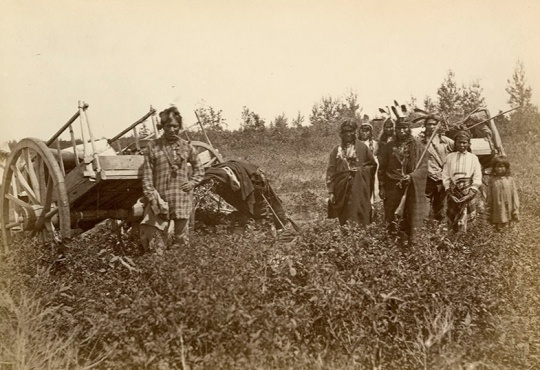
Ojibwe with Red River carts
Ojibwe with Red River carts near Fort Dufferin, Manitoba, Canada, ca. 1863.
Public domain
Holding Location
Articles
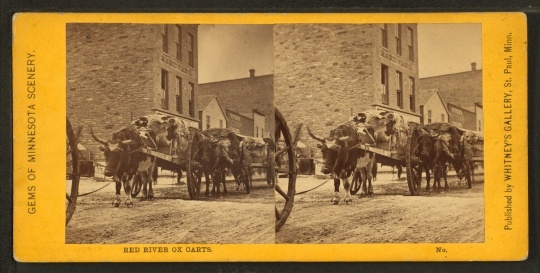
Red River carts
Red River carts, 1862–1875. Photograph by Whitney’s Gallery.
Public domain
Holding Location
Articles
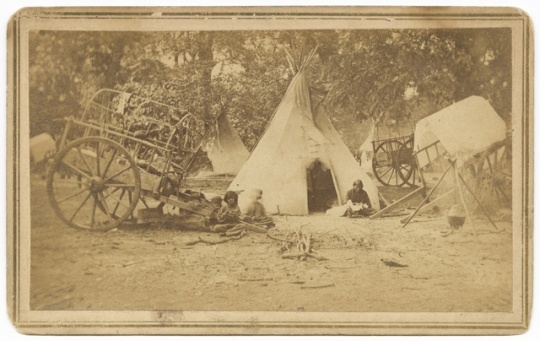
Dakota family and Red River carts
A Red River cart at a Dakota family’s camp, ca. 1870.
Public domain
Holding Location
Articles
More Information
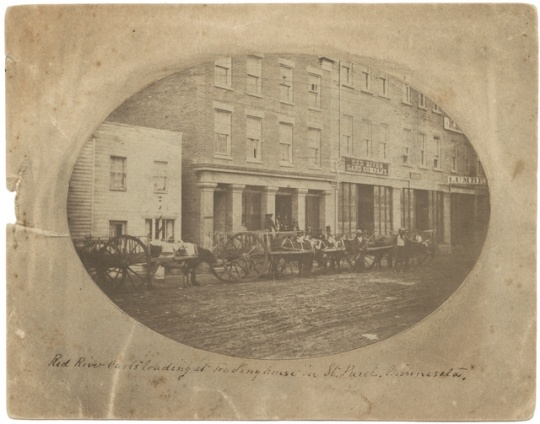
Red River carts loading at trading house, St. Paul
Red River Carts loading supplies at a trading house in St. Paul, 1854.
Public domain
Holding Location
More Information
Related Articles
Turning Point
In 1801, the precursor to the Red River cart is built by fur traders from French Canada living in present-day Pembina, North Dakota. Métis people went on to use the carts to establish a trading route to St. Paul.
Chronology
1801
1811
1810s
1821
1844
1849
1859
1881
Bibliography
Brehaut, Harry Baker. “The Red River Cart and Trails: The Fur Trade.” Transactions of the Manitoba Historical Society 3, no. 28 (1971–1972). http://www.mhs.mb.ca/docs/transactions/3/redrivercart.shtml
Gilman, Carolyn. “Perceptions of the Prairie: Cultural Contrasts on the Red River Trails.” Minnesota History 46, no. 3 (Fall 1978): 112–122. http://collections.mnhs.org/MNHistoryMagazine/articles/46/v46i03p112-122.pdf
Gilman, Rhoda, Carolyn Gilman, and Deborah M. Stultz. Red River Trails: Oxcart Routes Between St. Paul and the Selkirk Settlement, 1820–1870. St. Paul: Minnesota Historical Society Press, 1979.
History of the Red River Valley: Past and Present, Including an Account of the Counties, Cities, Towns, and Villages of the Valley from the Time of their First Settlement and Formation. Chicago: Cooper, 1909.
https://archive.org/details/historyofredrive01chicuoft
North Dakota State Government. The Métis and Red River Carts.
http://ndstudies.gov/gr4/frontier-era-north-dakota/part-2-fur-trade-red-river/section-4-métis-and-red-river-carts
Nute, Grace Lee. “The Red River Trails.” Minnesota History 6, no. 3 (Fall 1925): 278–282.
http://collections.mnhs.org/MNHistoryMagazine/articles/6/v06i03p278-282.pdf
Peihl, Mark. “Red River Carts Reviewed.” Clay County Archives, Historical and Cultural Society of Clay County, Moorhead.
Related Resources
Primary
Henry, Alexander. The Journal of Alexander Henry the Younger, 1799–1814: Red River and the Journey to the Missouri. North York: Champlain Society, 1988.
Nelson, George. My First Years in the Fur Trade: The Journals of 1802–1804. St. Paul: Minnesota Historical Society Press, 2002.
Secondary
Gilman, Rhoda. “The Last Days of the Upper Mississippi Fur Trade.” Minnesota History 42, no. 4 (Winter 1970): 122–140.
http://collections.mnhs.org/MNHistoryMagazine/articles/42/v42i04p122-140.pdf
Nute, Grace Lee. “New Light on Red River Valley History.” Minnesota History Bulletin 5, no. 8 (November 1924): 561–572.
Peterson, Jacqueline, and Jennifer S. H. Brown. The New Peoples: Being and Becoming Métis in North America. Winnipeg: University of Manitoba Press, 1985.
Web
Library and Archives Canada. Thomas Douglas, Earl of Selkirk (June 20, 1771–April 8, 1820).
http://www.bac-lac.gc.ca/eng/discover/politics-government/canadian-confederation/Pages/thomas-douglas.aspx?wbdisable=true











